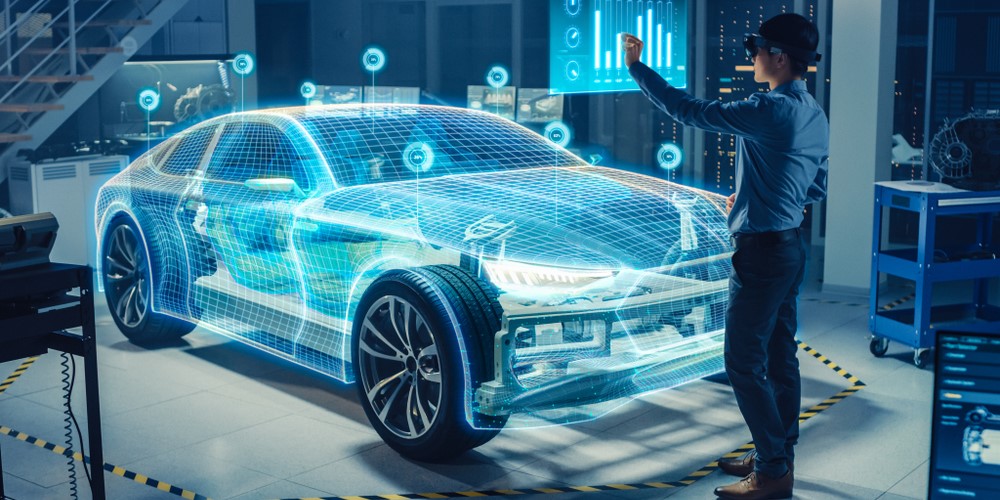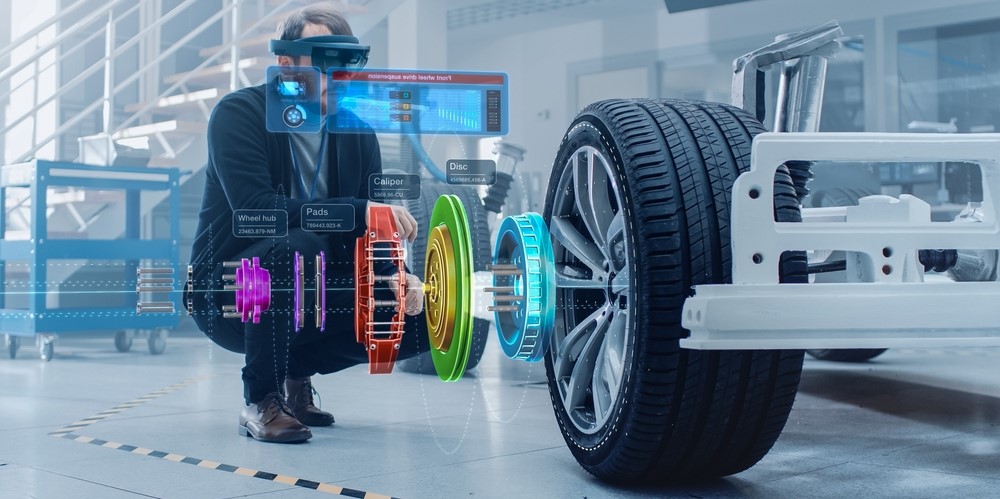Virtual Reality for Automobile Engineering Education and Training

From self-driving cars to electric vehicles, the automobile engineering sector is constantly evolving. With innovations that seem straight out of science fiction, staying ahead in this ever-changing field demands a fresh approach to education and training.
So, what is the solution to this?
The answer is Virtual Reality. The immersive world of VR for automobile engineering education is dynamic, interactive, and leaps beyond what traditional methods could ever offer.
But it's not just about theoretical knowledge, it extends to hands-on training as well. The interaction with the VR world during training ensures that the engineers of the future are well-prepared for the challenges awaiting them in the real world.
But how exactly can VR be applied in the context of automobile engineering education and training? Let’s explore it in the blog below.
What is VR for Automobile Engineering?
VR for automobile engineering is changing the way we educate and train automotive engineers. With virtual reality labs, budding students are offered a dynamic and interactive learning environment which cannot be achieved with traditional methods.
Asking how?
By wearing a VR headset, students have a unique opportunity to explore the inner workings of vehicles, from complex engines to advanced safety systems that too in a safe and controlled environment.
Well, the innovative approach of immersive engineering in education is not only limited to grasping the knowledge alone, it also extends to practical training.
With VR, the students can disassemble and reassemble the virtual engines that are replicas of the actual, real-life engines. This helps them to gain the necessary hands-on experience and insight into various automobile components.
Not only this, they can also diagnose the complex issues in the machines that too without viewing the physical vehicle. This type of interaction during training prepares the students for the challenges that are going to face in the real world.
VR for Automobile Engineering Education and Training
Virtual Reality (VR) is a technology that is already being used in the automotive industry to create virtual showrooms, conduct research and testing, and even train drivers and engineers.
VR engineering can fundamentally change the way cars are marketed, tested, and developed.
VR allows engineers and developers to predict and solve issues before they happen and enables learners to build their confidence and skills in VR environments, from meeting rooms to auditoriums.
Here are some ways VR can be used in automobile engineering education and training:
✔️ Virtual Prototyping
Virtual prototypes are one of the most valuable tools for industrial designers and VR engineers.
VR software optimizes the conception phase of product development by allowing designers to experiment easily with the look and build of a vehicle before commissioning expensive prototypes.
This can save the automotive industry millions in man-hours and material, by reducing the number of prototypes built per vehicle line and opening up the design process to a global workforce.
✔️ Training Scenarios
VR can be used to train novice drivers, professionals operating industrial equipment, or test vehicles and drivers in extreme conditions.
Before sending technicians or engineers to a potentially dangerous installation, it is important to give them proper training to assess the risks and safety of the workers.
VR can help set up training for situations that are otherwise too dangerous or too expensive to reproduce in real conditions.
They can go for virtual industrial visits with VR where they can learn about the use of machinery and tools in real-world situations without actually stepping into the real industrial setup.
✔️ Visualize and Interact with Complex Data
VR in mechanical engineering can help designers, engineers, and other related specialists visualize and interact with complex data. For instance, designers can benefit from Virtual Reality technology by creating the most detailed factory prototypes and coming up with all the functionality.
✔️ Employee Training
VR provides many employee training opportunities to help professionals better design and engineer cars. BMW includes employee VR training while preparing their specialists to encounter customers.
VR can also be used to assist employees in visualizing the virtual selling experience to make their customer service top-notch.
"Level up your skills with virtual reality! Explore the future of learning automobile engineering and boost your career!"
Benefits of VR in Automobile Engineering Education

The immersive technology of VR offers an invaluable opportunity for learners to interact with virtual vehicles, dissecting engines, and analyzing intricate components with unprecedented precision.
Some of the benefits of using VR to train engineering students are as under-
✔️ Immersive Learning Environments
The creation of immersive learning environments is one of the most significant advantages of integrating VR into automobile engineering education.
After the advent of VR, students are no longer restricted to the four walls of the classroom, reading textbooks, looking at static diagrams, or even traditional computer simulations.
Instead of all these, the students are transported into an interactive environment that is meticulously designed where they can explore every aspect of a vehicle, from the engine to the transmission, suspension, and beyond.
Here, they can stand in a virtual room with an engine present over there. They can turn it over, examine its components, and understand how they work in combination with each other.
It doesn’t end here!
VR helps educators to provide immediate feedback and guidance to their students. This means teaching complex subjects, be it about teaching asphalt paver or a jet engine, is easy and effective now.
✔️ Realistic Simulations
When it comes to creating realistic simulations that mirror real-world scenarios, VR goes a step further. This includes all the impractical, dangerous, or costly scenarios that are impossible to replicate in a physical lab or classroom.
These realistic simulations in VR to train engineering students can help the students witness the performance of vehicles under various conditions, empowering them to grasp the practical implications of their designs.
Now let’s talk about crash testing. It is a vital aspect of automotive engineering safety.
conducting physical crash tests on vehicles in a traditional setting is not only expensive but also poses significant safety risks.
However, in the VR world, students can witness and participate in these tests, observing the impact on vehicle integrity, occupant safety, and structural performance.
This firsthand experience is invaluable in reinforcing the importance of safety engineering in the automotive field.
Not only this, VR has the potential to replicate extreme weather conditions, from heavy rain to extreme heat.
If you are wondering what is its advantages, then you must know that with these simulations, see how different vehicle components and systems respond to these conditions and gain insights into the complexities of engineering solutions for adverse environments.
 Get the App from Meta Store: Download Now
Get the App from Meta Store: Download Now
✔️ Hands-On Experience without Physical Constraints
Traditional automobile engineering education often faces limitations when it comes to hands-on experience.
Why?
It can happen as the access to physical components and systems for experimentation is often restricted by resource availability, cost, or safety concerns. Virtual Reality eliminates these constraints.
VR labs for engineering provide students with a hands-on experience that is not bound by physical limitations.
The virtual world created by VR allows students to interact with virtual components, disassembling and reassembling complex systems, and troubleshooting issues without the need for a physical lab setup.
This not only reduces the financial burden associated with maintaining and upgrading physical labs but also ensures that students can experiment freely without concerns about safety or resource availability.
This freedom to explore and experiment in a risk-free environment is instrumental in nurturing innovation and problem-solving skills.
Students can make mistakes, learn from them, and refine their understanding without the fear of damaging expensive equipment.
As a result, they graduate with the confidence and proficiency required in the field of automobile engineering.
✔️ Customized Learning Paths
Another remarkable aspect of VR in engineering education is the ability to tailor learning experiences that accommodate the different learning styles and paces of each student.
Educators can customize the VR platform to meet the unique needs of each student which ensures that they receive an optimal learning experience.
In a traditional classroom, one-size-fits-all teaching methods can leave some students struggling to keep pace while others become disengaged due to a lack of challenge.
However, with VR, students can progress through immersive and interactive modules at their own speed. They can revisit challenging concepts or fast-track through familiar ones.
Such adaptability ensures that every student remains engaged and motivated, resulting in a more effective learning experience.
Impressive isn’t it?
Well, customization in VR also extends to the content itself.
Instructors can create a diverse range of learning modules, that can accommodate various learning preferences.
Whether a student is a visual learner, a kinetic learner, or benefits from auditory explanations, VR can cater to their individual needs.
This personalized approach promotes a deeper understanding of the subject matter, fostering a higher level of competence and confidence among students.
✔️ Global Collaboration and Remote Learning
Virtual Reality platforms enable global collaboration and remote learning opportunities. Thus, bringing together students from different parts of the world.
This interconnectedness is a powerful asset as it allows students to work together on projects, share insights, and gain benefits from diverse perspectives and approaches.
Imagine a collaborative project where students from different countries collaborate in a shared virtual workspace to design and optimize a new vehicle model.
Each student brings their unique cultural and educational background to the table, resulting in a more comprehensive and innovative final product.
VR encourages this kind of collaboration, ensuring that future automobile engineers are not only technically proficient but also well-versed in global perspectives and approaches to automotive engineering challenges.
✔️ Industry Integration and Skill Development
Beyond the educational world, VR is rapidly gaining traction in professional training within the automobile engineering industry.
A lot of established automotive companies like BMW are employing VR to upskill their workforce, offering realistic simulations for maintenance, repair, and testing procedures.
Well, this not only enhances the proficiency of technicians but also ensures that they are well-versed in the latest advancements in automotive technology.
The Future of Automobile Engineering Education
What will be the future of Automobile Engineering education with VR?
We can say that as VR technology continues to advance, so too will its applications in education and training.
With the integration of haptic feedback and augmented reality elements, the line between virtual and physical experiences will blur even further.
This promises an even more comprehensive and intuitive learning experience for future automobile engineers.
In conclusion, Virtual Reality is there to change the world of automobile engineering education and training.
Its immersive capabilities, realistic simulations, and adaptability make it an invaluable tool for both students and industry professionals.
As this technology continues to evolve, the future of automobile engineering education looks brighter and more dynamic than ever before.
Well, embracing VR today is not just a leap into the future, instead, it's a strategic step towards excellence in automotive engineering education.




